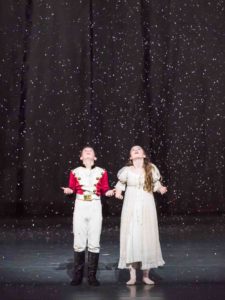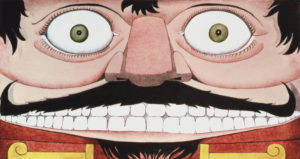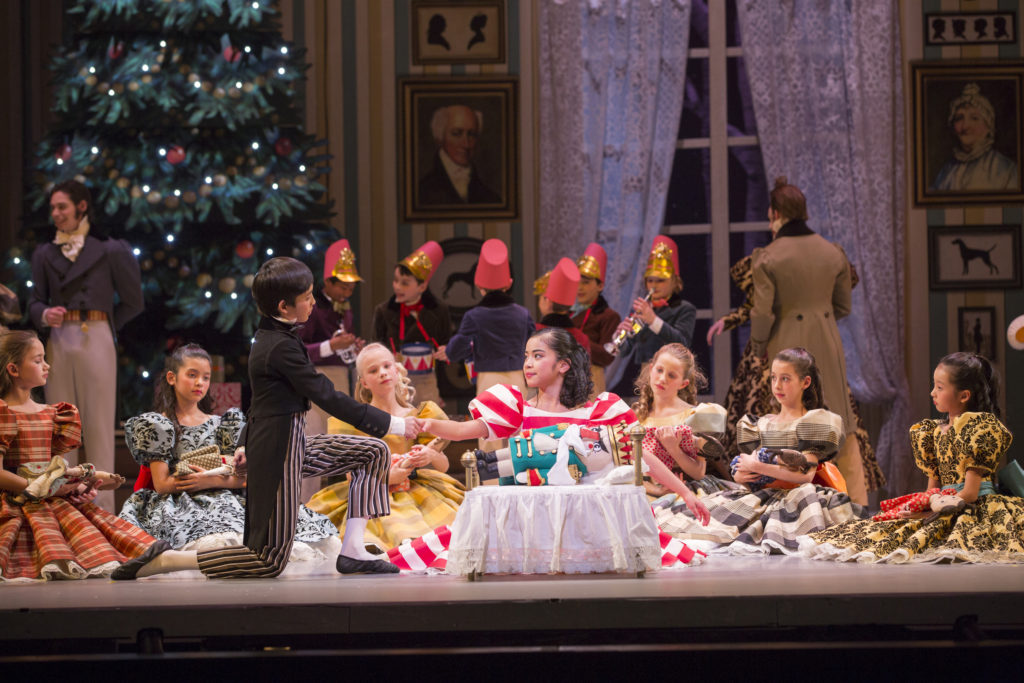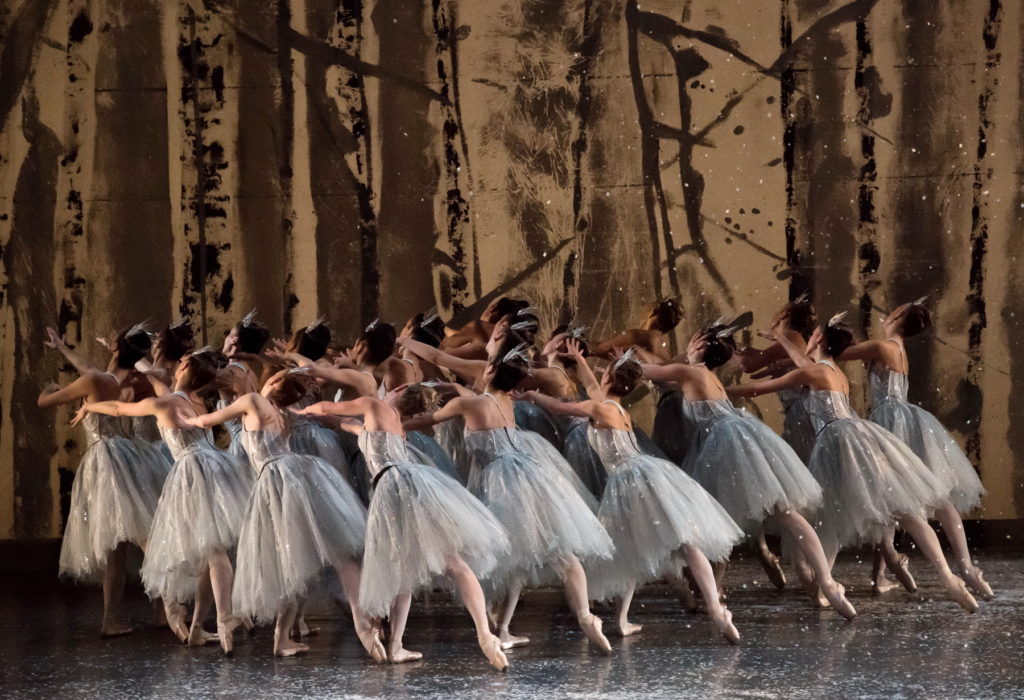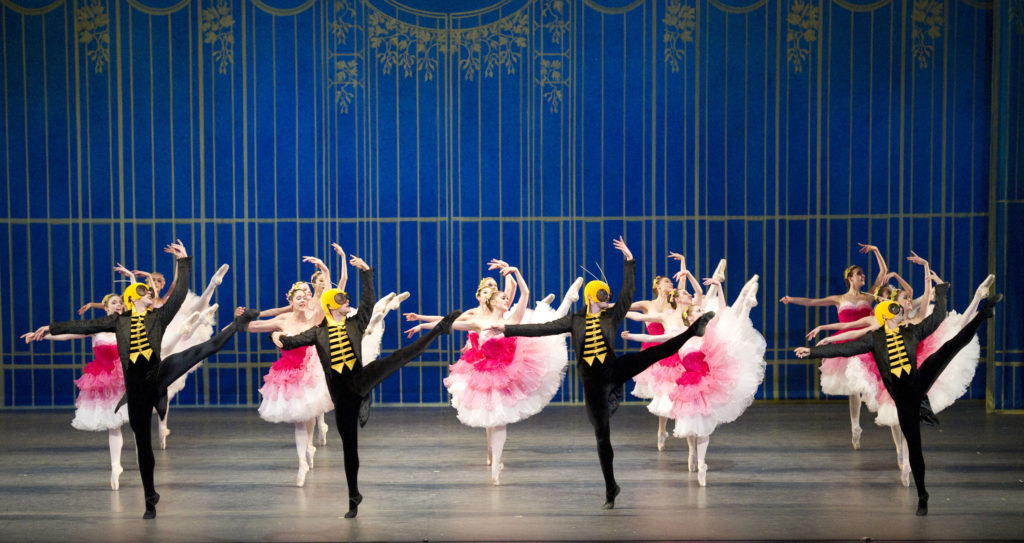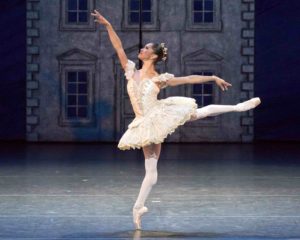Two highly anticipated, top-draw Nutcracker productions that premiered on the West Coast last season — Peter Boal’s new setting of “George Balanchine’s The Nutcracker” at Pacific Northwest Ballet in Seattle, and Alexei Ratmansky’s 2010 “The Nutcracker” for American Ballet Theatre, now relocated to Costa Mesa — had somewhat soft landings their first time out. “We look at life once in childhood; the rest is memory,” as the poet Louise Glück said, which means paying Nutcracker attendess are revved particularly high in their need for drama, magic and past resonance. Thus when both new adaptations asked viewers to try new flavors, expressions naturally pulled and scrunched.
Two Expensive Debuts
Up in Seattle, the inaugural year of a gilded new $3 million Nutcracker, featuring George Balanchine’s licensed choreography with new designs and costumes by Ian Falconer (“Olivia the Pig”), also meant the dismantling of one of the country’s most unique and holistic Nutcrackers. Citing a need to boost ticket sales, PNB artistic director Peter Boal shuttered the 1983 version featuring visual and narrative designs by Maurice Sendak (“Where the Wild Things Are”) and choreographed by PNB co-founder Kent Stowell.
Though an economic mainstay for PNB, running for a full month each year and reportedly generating approximately 25 percent of PNB’s annual $22 million dollar budget, the acclaimed Sendak/Stowell version had recently begun to show some sales decline, the company reported.
But what a divisive decision, to close it completely. The production was indeed 32 years old, and Seattle’s demographic is changing, but the unique tone and vision of the romp summoned a holiday spirit that blended sublimely with the Northwest milieu. (This in a city that has suffered unfortunately, in the last century, from other expensive projects — Venturi and Brown’s Seattle Art Museum, Frank Gehry’s Experience Music Project — that interpreted Seattle’s youthfulness and independence with works of awkward whimsy.)
And though sales may have been slagging, public sentiment and distress over the announced closure of the Sendak/Stowell production spiked an enormous response. In 2014, its final year, ticket sales skyrocketed from a $3 million annual haul to over $8 million.
Why such audience devotion? For one, Sendak died rather recently, in 2012, rendering this his only design for the ballet stage. And though captured in a film and book, neither match the McCaw Hall experience. Thick-lined, oversized and shapely cut, Sendak’s set illustrations and costumes conjured a jaunty, elfin tale befitting this modest, bookish city. Stowell (a native of Idaho) chose to follow a later Russian tradition that streamlined the love story, eliminating the Sugar Plum Fairy so an adult Clara reigned as leading lady in Act II. Though the choreography was not Balanchine-brilliant, the spunky characters and the organized narrative made an impact on kids and adults alike. Savoring jealousy, frights, swooning desires, and prideful battles, PNB’s “The Nutcracker” neatly conveyed Sendak’s belief in “the pleasure of having your child self intact and alive and something to be proud of.”
As well, the Sendak version bore a gentle, true imprint of the Northwest region and culture — more exotic than elite, a dark field spiked with hidden treasures. For generations of Seattleites, “The Nutcracker” meant — along with the growing tree and mouse battle — a string of dolphins leaping from a rolling sea, a strange and rollicking Chinese tiger, and a shy and imperious peacock emerging from a barred cage. Only Sendak’s wand, when waved over this specific city, seemed to enable Tchaikovsky’s divertissements to give up such new life.
Crowning a New Era
Thirty-two years later, Peter Boal’s commissioning of a sumptuous, elevating new production of “The Nutcracker” surely intended to be a kind of coronation, a crowning to befit PNB’s current national stature and accumulated history. Licensing “George Balanchine’s The Nutcracker” nodded to the company’s excellent Balanchine/NYCB pedigree, clearly established by former artistic director Francia Russell and continued by Boal. Employing Falconer, another clever and distinctive illustrator, referenced the spirit of Sendak and the city’s literary minded audience.
Boal had already proved his skills at illuminating story ballet for PNB, particularly in his shepherding of an ambitious restoration of “Giselle” in 2011. (That production’s acclaimed Romantic-era authenticity — bearing a marvelously strange and vivid other-ness — presaged Alexei Ratmansky’s own significant historic revival of “The Sleeping Beauty” in 2015.) With “The Nutcracker,” however, Boal (who’d danced in NYCB’s version since the age of 10) eschewed its historic 1892 St. Petersburg origins — Balanchine’s inspiration — and set it on a hidden, turn-of-the-century New England estate.
Falconer’s detailed sets (22 painted drops) conveyed the dreamy, Beaux-Arts elegance to a tee: well-proportioned rooms, deep and layered, with textured furniture and costumes in patterned velvets and satins. In consort with the Tchaikovsky, the sets and costumes burst with amplitude, freshness and warmth. A short 3D animated film played during the overture, adding poetic depth and mood: audiences shared in the journey to Clara’s remote manor house, coasting along snow-covered forest paths and country lanes where the woods were never more lovely, dark, and deep. (Good news this season: Straightface Studios created a second video following the Party scene that incorporate live-action ballet dancers inside a computer-generated world, hopefully deeply wintry as well.)
Like Sendak, who framed the stage action with a painted holiday border, Falconer’s design included side panels, these featuring Olivia the Pig with some human friends, seated in a loge box. Drawn with a delicate line, inked in ballet-pink, Olivia — and her patrician cohorts — are a natural part of ballet’s rarefied milieu: other than her oversized snout and animal ears (more terrier than pig), Olivia’s bearing is aristocratic. A further delineation of dynasty, Nutcracker-style, was indicated by a scrim of cameo heads at the top of the stage that depicted Alexander Dumas, E.T.A. Hoffman, Peter Illyich Tchaikovsky, Marius Petipa, Lev Ivanov, George Balanchine and Lincoln Kirstein. A tiny child rabbit in military uniform — who appeared briefly in the fight scene — provided the only addition to the standard character portraits already in the show. Thus while a certain charm and playfulness was retained by Falconer here, the gate-crashing spirit of Sendak — sneaking chubby nymphs and eye-rolling monsters to frolic in ballet’s lofty heights — was indeed over.
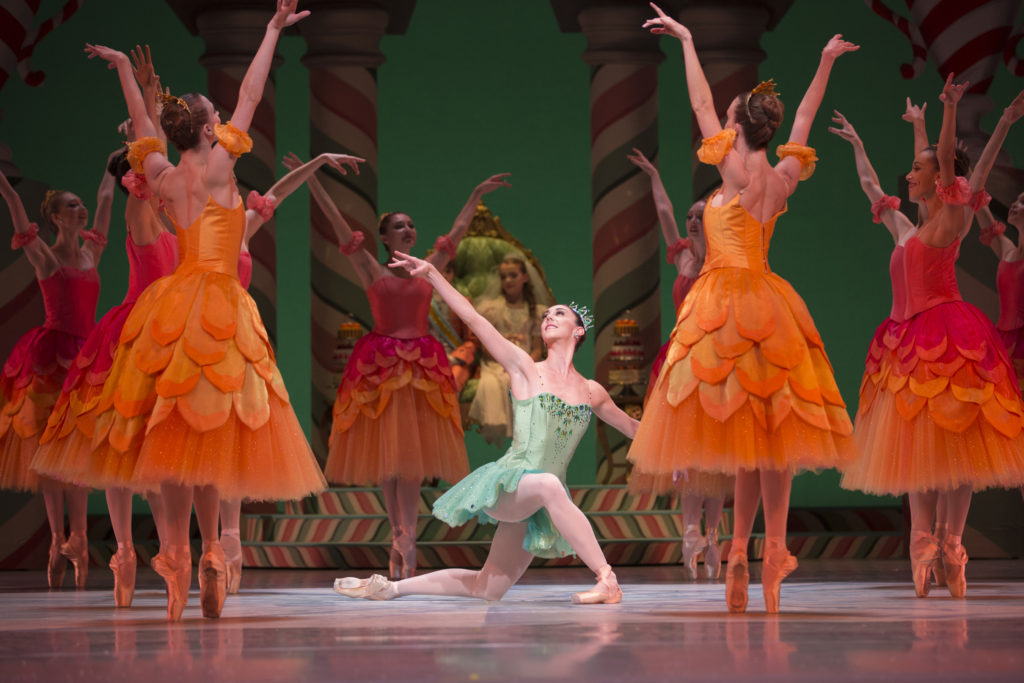
Ian Falconer’s Nutcracker design shoots the traditional holiday color values into a new orbit. Photo: Angela Sterling
The virtuosic element in Falconer’s new design was its emulsification of color and pattern. Stripes, brocades, lace; tutus as cupcake wrappers; ensembles dressed in inconceivable ambrosias (deep orange flowers with a minty-green Dewdrop leader) or radical departures from tradition (the Sugar Plum Fairy wore sugary grape) — achieved pure alchemy thanks to James F. Ingalls’ hard-working lighting design.
Echoing Olivia perhaps, a stunning array of pink hues worked as a through line, with only one distracting misstep: Mother Ginger’s carnival-tent costume — a sunny explosion of yellow and white stripes, with cheery blue piping — featured a matching headdress and entry door (for her children) made from a puckered pink satin that, given its positioning and texture, read distractingly like labia.
Though PNB is only the second West Coast company to license “George Balanchine’s The Nutcracker,” (after Portland’s Oregon Ballet Theatre) every semi-pro and school production mimics the Balanchine storyline and choreography to some degree. Thus it was hard for Seattleites not to feel that the narrative’s return to the Land of Sweets and its zig-zag arrow of love (Clara to Drosselmeier’s nephew to Sugar Plum Fairy and Cavalier) as anachronistic, and a kind of lessening.
Still, the momentum building towards Act II’s final dances — the Waltz of the Flowers and the final Pas de Deux — was undeniable, and the personality and nuance in Balanchine’s choreography beat back against the shortcomings. During the Sunday evening performance on Dec. 20th — at the exciting point in the run when younger dancers were rotating into premiere casting spots — Leah Merchant and Joshua Grant made a strong and likeable lead pair, while sprightly Angelica Generosa as Dewdrop danced with the kind of overflowing spirit that builds lasting audience allegiance. Watching Generosa elucidate the darting Balanchine jumps, one could fully appreciate why Boal — despite the challenges — wanted to deliver this *exact* choreography to his wonderful dancers, and nothing less.
Ticket sales were not a disappointment: the company earned $7.7 million this first season, certainly sparked by its premiere status. The passing of time, and the continued cultivation of dancers with bright and independent energies, will help Seattle audiences feel that this imperial production belongs to their city. Yet on this complicated opening year, even the appearance of Dale Chihuly’s giant glass Winter Star in the snow scene — the moment of Seattle visual branding — felt like one more cool and expensive import.
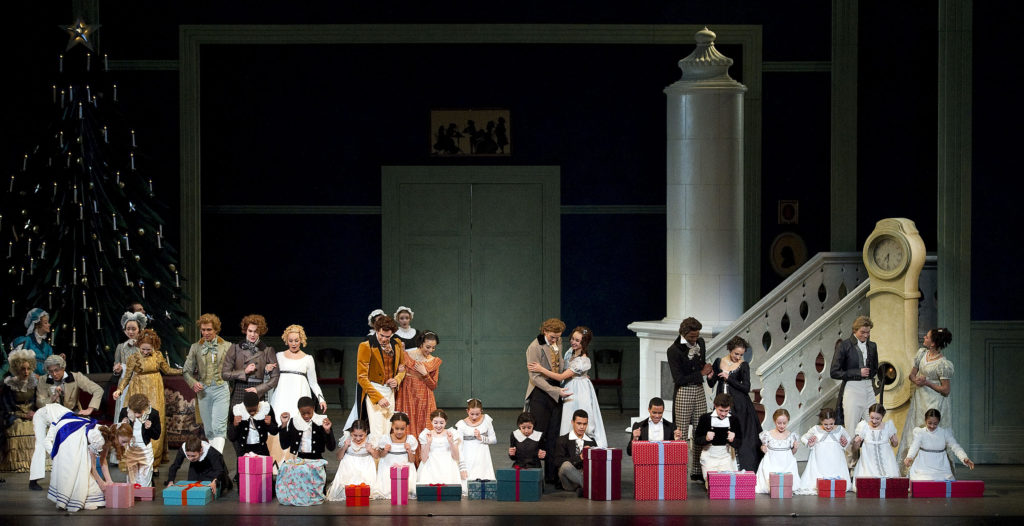
Richard Hudson’s designs for Ratmansky’s party scene have a sparse, drafty feel. Photo: Gene Schiavone
Ratmansky’s Russian Holiday
Where Seattle’s new Nutcracker trumpeted prestige and prosperity, American Ballet Theatre’s 2010 version by Alexei Ratmansky — which moved from the Brooklyn Academy of Music to the Segerstrom Center in Costa Mesa — left some expectant SoCal audiences scratching their heads at its quizzical design and challenging interpretations of the music. This strange unweaving of tradition was “The Nutcracker” as conceived for America’s finest ballet royalty?
The design schema by Richard Hudson (ABT’s “The Sleeping Beauty,” Broadway’s “The Lion King”) and lighting by Jennifer Tipton — featuring disorienting shifts in tone — was one bewilderment. First, there was simplicity and symbolism, with a plain scrim featuring an illustration of a crooked house in outline, floating free. From there, detailed realism took over, with a crisp, black-and-white tiled kitchen setting, where the pre-party action opened with a scene of merry, organized chaos between cooks, children, parents, and mice.
Then, when the activity moved into the public drawing room, though all the requisite Nutcracker elements were present (tree, clock, gifts), nothing in the scene felt solid, or seemed to truly conceal its artifice. Adults got drunk fast, and moved chaotically; in the corner there stood a massive white pillar that seemed to be hiding some later set piece. Was this sense of veneer intentional, meant to suggest a sense of theatricality and hollowness afoot? Or even penury? The children’s dresses — cut from thin white fabric, so incomplete and ordinary — were hardly fit to keep out the chill.
Atop these disorienting visual cues, Ratmansky employed so much more mime than usual, it was no longer a dancing party — just a messy holiday party. As such, the Tchaikovsky score no longer barreled along with warming reassurance. More and more, the redolent melodies seemed to deepen and gather with mystery and foreboding.
With the entrance of Herr Drosselmeyer, the thin, cockeyed world of the stage began to spark with magic, then eventually swell with true danger, heroism and balletic dance. Delivering his life-sized dancing dolls to the party, this lovely Drosselmeyer wasn’t demonstrating power and control. Instead, he liberated his marvelous creations and set splendid adventure in motion.
Indeed, this whole ballet was wondrously free. It stuck to no contracts. If the music sped up, the dancers might speed up, or they might not. The Christmas tree, conjured by prodding horns and beckoning strings, did indeed grow. Yet though tradition would have the trio of Russian dancers bursting through the gates to match the full-tilt gallop of their music, in this case they had too much to drink to go airborne. The magical travels of Tchaikovsky’s celesta was not demonstrated with prancy pointe work here, but there were kaleidoscopic patterns of snowflakes and waltzing flowers, though these female societies were neither kind (the snowflakes menaced) nor chaste (the flowers were ravished by a quartet of male bees).
If Balanchine’s “Nutcracker” was an ode to his origins in Imperial Russia, as well as a paeon to a sugary pink winter, Ratmansky’s “Nutcracker” refers more to the Soviet era, with Gorky’s streamlined Clara-centric plot (no Sugar Plum Fairy) and a somewhat dismantled, diffuse and dangerous setting. Ballet is not the language of life here, as it in in Balanchine’s version. It is much more rare and isolated, emerging fiercely, and swelled to burst, only from moments with the highest stakes. And nothing has higher ones than the Act II Pas de Deux, which features unearthly partnering challenges that can lead to epic fails when things go wrong. During Isabella Boylston’s debut as Clara last season, she and partner Cory Stearns were unable to obtain lift-off for the climactic overhead traveling arabesque and Stearns valiantly carried on, walking the downstage diagonal with Boylston draped on top of his head. (A week later, on their second try, the duo clinched it.)
As with Seattle, this new “Nutcracker” is going to require an adjustment period. Though houses were not fully filled in the first year — Misty Copeland’s two performances were the best sellers, and this year she is featured on opening night — Segerstrom representatives described overall sales as “quite strong.” And though ABT resides most of the year in New York, this “Nutcracker” move coincided with the opening of ABT’s new West Coast training school, the William J. Gillespie School, also at the Segerstrom Center. Having a year-round community of ABT-trained students in Costa Mesa, ready to fill annual casting needs for “Nutcracker,” will surely help to situate this dramatic story in its sunny new home.
Pacific Northwest Ballet
“George Balanchine’s The Nutcracker”
McCaw Hall, Seattle
Nov. 27 – Dec. 28, 2016
American Ballet Theatre
“The Nutcracker” by Alexei Ratmansky
Segerstrom Center, Costa Mesa
Dec. 9-18, 2016
